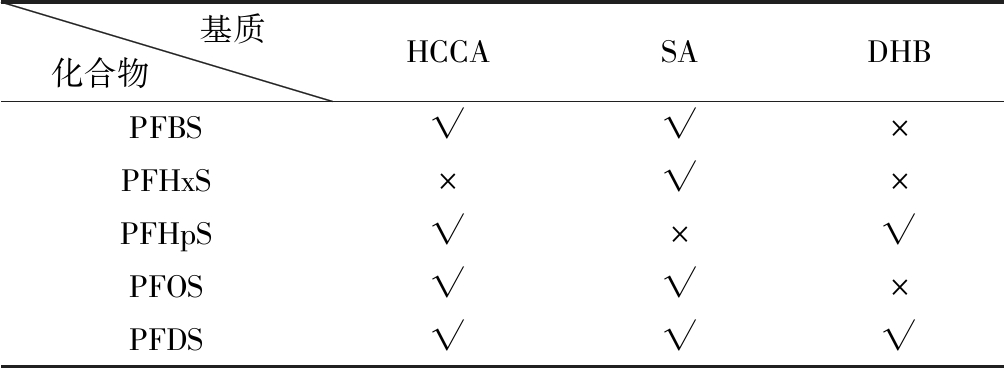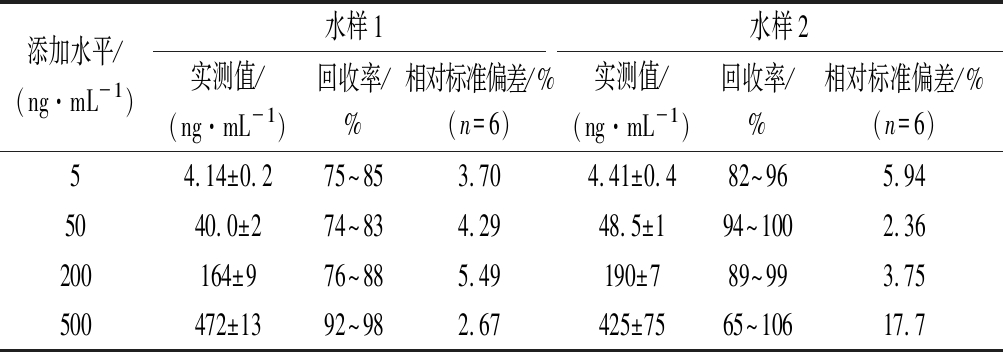全氟化合物(perfluoroalkyl sulfonic acid compounds, PFCs)是一类环境中新型持久有机污染物,包括全氟烷基磺酸、全氟烷基羧酸、全氟烷基磺酰胺三类,其中应用最广泛的PFCs是全氟辛烷磺酸(perfluorooctanesulfonic acid, PFOS) 和全氟辛酸(pentadecafluorooctanoic acid,PFOA)[1-3] 。PFCs具有迁移能力,普遍存在于水、土壤、植物动物源性食品中[4-6] ,通过食物链累积,可对人体的健康造成影响[6-7]。目前,分析全氟化合物的方法主要是液相色谱-质谱法[2-3,8-9]或气相色谱法[10-11],但这2种方法耗时较长、样品制备较复杂。同时由于仪器中管路材料的影响,可能引起系统本底背景值的升高[8],从而影响痕量分析的准确性。因此,迫切需要开发简单、高通量的PFCs 分析方法。
基质辅助激光解析电离飞行时间质谱(matrixassisted laser desorption ionization time of flight mass spectrometry,MALDI-TOF MS) 是一种强有力的生物大分子分析工具,具有高灵敏度、实验周期短、前处理简单、样品消耗量低等优点,主要用于蛋白质、多肽、多糖、聚合物的分析[12-13],目前国内外已有一些学者将该方法成功用于环境中苯并芘、抗生素、酚类等小分子污染物的分析[14-18]。α-氰基-4-羟基肉桂酸(α-cyano-4-hydroxycinnamic acid,HCCA)、2,5-二羟基苯甲酸(2,5-dihydroxybenzoic acid,DHB)、芥子酸(sinapinicacid,SA)是MALDI 分析常用的基质,在大分子检测中得到广泛的应用,它们通常被认为在激光照射下容易产生碎裂片段对目标物造成干扰,不适用于分子质量500 Da 以下化合物的分析[19-21]。而有机金属框架材料[14] 、纳米材料[16]、金属有机骨架纳米复合材料[15,18]等材料近年来被开发作为MALDI-TOF MS方法的新基质材料,用于小分子物质的分析。常用的基质与新基质相比,不需要进一步的鉴定,并且可购买获得,价格便宜,对检测仪器安全可靠。关于这3种常用的基质对小分子待测物的具体干扰、负离子模式检测下的MALDI 质谱信号等方面较少报道。
本文拟探索MALDI-TOF MS技术的常用基质在负离子模式下检测全氟烷基磺酸类化合物,旨在建立一种新的全氟烷基磺酸类化合物检测方法,实现快速、有效检测。通过内标定量的方法建立PFOS的MALDI-TOF MS定量分析,能实现环境水样中PFOS的定量检测。
1 材料与方法
1.1 实验材料
1.1.1 主要试剂
HCCA、DHB、SA,美国Sigma-Aldrich公司;全氟丁烷磺酸、全氟癸烷磺酸,加拿大TRC公司;全氟己烷磺酸、全氟庚烷磺酸、全氟辛烷磺酸,德国DR公司;全氟辛烷磺酸钠内标,加拿大Wellington公司;甲醇(色谱纯),美国Thermo Fisher Scientific公司。具体见表1。
表1 基质及全氟烷基磺酸化合物信息
Table 1 Matrix and perfluoroalkyl sulfonic acid compound information

序号中文英文及缩写结构式分子式平均分子质量CAS[M-H]-1α-氰基-4-羟基肉桂酸4-hydroxy-α-cyanocinnamic acid,HCCAC10H7NO3189.167 928166-41-8188.034 222,5-二羟基苯甲酸2,5-dihydroxybenzoic acid,DHBC7H6O4154.120 4490-79-9153.018 23芥子酸sinapinic acid 3,5-dimethoxy-4-hydroxycinnamic acid,SAC11H12O5224.2104530-59-6223.060 14全氟丁基磺酸perfluorobutanesulfonic acid,PFBSC4HF9O3S300.099 5375-73-5298.941 95全氟己烷磺酸perfluorohexanesulfonic acid,FHxSC6HF13O3S400.114 6355-46-4398.935 56全氟庚烷磺酸perfluoroheptanesulfonic acid,FHpSC7HF15O3S450.122 1375-92-8448.932 37全氟辛烷磺酸perfluorooctanesulfonic acid,PFOSC8HF17O3S500.129 7 1763-23-1498.929 18全氟癸烷磺酸perfluorodecanesulfonic acid,PFDSC10HF21O3S600.144 8335-77-3598.922 79全氟辛烷磺酸钠sodium perfluoro-1-[1,2,3,4-13C4]octanesulfonate, MPFOS13C124C4F17SO3 Na526.111 5/502.929 1[M-Na]-
注:平均分子质量和[M-H]-的分子质量数据由Bruker Compass Utilities计算得到(Isotope Pattern版本2.0);/表示CAS未知
1.1.2 仪器与设备
ultrafleXtreme基质辅助激光解析电离飞行时间质谱,德国Bruker Daltonics公司;2600TH超声清洗器,上海安谱科学仪器有限公司;SECURA224-1CN电子天平,德国Sartorious公司;M37 610-33CN涡旋混合器,美国Thermo Fisher Scientific公司;Milli-Q超纯水系统,美国Millipore公司。
1.2 实验方法
1.2.1 基质的配制
称取适量的HCCA、DHB、SA固体分别溶解于一定量的甲醇水(体积比1∶1)溶液中,配制成10 mg/mL的基质溶液,超声溶解。
1.2.2 全氟烷基磺酸溶液及标准曲线的配置
全氟烷基磺酸标准储备溶液1 mg/mL,分别准确称取5种全氟烷基磺酸标准品0.010 00 g置于10 mL容量瓶中,用甲醇溶解并定容至刻度,摇匀,作为标准贮备溶液,于-18 ℃冰箱内冷冻保存。
取上述5种标准储备溶液0.1 mL于50 mL容量瓶中,用甲醇水(体积比1∶1)定容至刻度,配成2.0 μg/mL混合标准溶液。分别取0.025、0.05、0.10、0.25、0.50、2.5 mL混合标准溶液(2.0 μg/mL)于6个不同的10 mL容量瓶中,同时加入全氟辛烷磺酸钠内标,用甲醇水定容至刻度,配成5、10、25、50、100、500 ng/mL标准工作液,内标质量浓度为10 ng/mL。
1.2.3 样品的准备
取1 μL待测液滴加于不锈钢靶板上,待其干燥后,再迅速滴加基质溶液1 μL,在自然条件下待干燥后,把靶板放入仪器。
1.2.4 数据采集分析
基质辅助激光解析电离飞行时间质谱仪器配备smartbeam-ⅡTM激光,频率为2 000 Hz,激光能量设置为30%~50%,在负离子反射检测模式下质荷比(m/z)扫描范围为100~3 500,数据处理采用Flex Analysis 3.4软件。
2 结果与分析
全氟烷基磺酸类化合物含有磺酸基团,易在负离子模式下被MALDI-TOF MS分析检测。LI等[16]研究以TiO2 NS、P25 TiO2等作为基质,分别在反射的正、负离子模式下进行分析,在正离子模式下均未观察到显著的全氟辛烷磺酸特征峰,而在负离子模式能观察到特征峰。根据目标化合物的特点,本实验仪器方法设置为负离子反射模式,以HCCA、SA、DHB为基质,对5种全氟烷基磺酸类化合物进行测定。
2.1 负离子模式下的基质谱峰
在负离子反射模式下,对HCCA、SA、DHB 3种基质本身测定,能明显观察到3种基质自身的准分子离子峰,[HCCA-H]-(m/z 188.1)、[SA-H]-(m/z 223.2)、[DHB-H]-(m/z 153.1)。除此之外还有二聚体峰、Na+与基质结合峰等其他形式的聚合峰,如[2HCCA-H]-(m/z 377.2)、[2HCC+Na-2H]-(m/z 399.2)、[2DHB-H]-(m/z 307.2),[2SA-H]-(m/z 447.2)等,这与郝春雁等[20]的研究结果一致,结果如图1 所示。
2.2 对待测物的影响
5种全氟烷基磺酸类化合物为被分析物,分别与3 种基质直接混合于样品靶上,质谱图上能非常明显地观察到[PFBS-H]-(m/z 299.1)、[PFHxS-H]-(m/z 399.1)、[PFHpS-H]-(m/z 449.1)、[PFOS-H]-(m/z 499.1)、[PFDS-H]-(m/z 599.1)的特征峰,分子质量偏差小于0.05% ,与软件拟合的[M-H]-一致。全氟烷基磺酸类化合物容易在负离子模式下被解离成[M-H]-形式,且成为最稳定和主导的阴离子,主要是因为强C—F键尾的吸电子效应。

a-DHB;b-SA;c-HCCA
图1 基质的负离子反射模式质谱图
Fig.1 Mass spectrometry of marix using negative ion reflection mode
在HCCA作基质时,实验中虽然没有加入Na+,但质谱图中含有[2HCCA+Na-2H]-(m/z 399.1)的信号峰,对PFHxS的检测结果存在干扰,如图2所示;在SA作基质时,[2SA-H]-(m/z 447.2)的同位素峰对PFHpS的检测结果存在干扰,如图3所示;在DHB作基质时,m/z 为299.2、399.3、499.2的基质峰对PFBS、PFHxS、PFOS的检测结果存在干扰,如图4所示。各基质对被分析物的适用性如表2所示。且由于SA和DHB基质偏硬,检测时需要的激光能量高于HCCA,但是离子峰强度却低于HCCA,信噪比也差于HCCA,因此选用HCCA作基质检测全氟烷基磺酸类化合物要优于SA和DHB。

A-matrix blank;B-perfluoroalkyl sulfonic acid compound
a-PFBS;b-PFHxS;c-PFHpS;d-PFOS;e-PFDS
图2 以HCCA作为基质的5种全氟烷基磺酸类化合物质谱图
Fig.2 Mass spectra of perfluoroalkyl sulfonic acid compounds using HCCA as matrix
表2 不同基质测定全氟烷基磺酸类化合物标准品的情况
Table 2 Performances of perfluoroalkyl sulfonic acid standard analyzed using different kinds of matrix

基质化合物 HCCASADHBPFBS√√×PFHxS×√×PFHpS√×√PFOS√√×PFDS√√√
注:“ √”表示基质适合该化合物的检测;“×”表示基质不适合该化合物的检测
2.3 全氟辛烷磺酸内标定量曲线的建立
用甲醇水配制5、10、25、50、100、500 ng/mL系列质量浓度PFOS标准溶液,MPFOS内标质量浓度为10 ng/mL,点样后在选定的最佳质谱条件下进行数据采集,以PFOS和MPFOS分子离子峰的峰面积之比与PFOS的浓度进行定量。结果表明,该方法在5~500 ng/mL具有很好的线性关系,线性相关系数R2 = 0.997 9,如图5所示。将标准溶液逐步稀释,以最低浓度系列化合物的响应值3倍信噪比对应的浓度为检出限,以大于10倍信噪比浓度为定量限,方法的检出限为1 ng/mL,定量限为5 ng/mL。
在GB 5009.253—2016 《食品安全国家标准 动物源性食品中全氟辛烷磺酸(PFOS)和全氟辛酸(PFOA)的测定》标准中,采用同位素稀释液相色谱-串联质谱测定方法测定PFOS,单个样品的上机检测时间约为10 min,而采用MALDI-TOF MS内标法在1 min内获得信号峰,能缩短检测时间,有效提高检测效率。

A-matrix blank;B-perfluoroalkyl sulfonic acid compound
a-PFBS;b-PFHxS;c-PFHpS;d-PFOS;e-PFDS
图3 以SA作为基质的5种全氟烷基磺酸类化合物质谱图
Fig.3 Mass spectra of perfluoroalkyl sulfonic acid compounds using SA as matrix

A-matrix blank;B-perfluoroalkyl sulfonic acid compound
a-PFBS;b-PFHxS;c-PFHpS;d-PFOS;e-PFDS
图4 以DHB作为基质的5种全氟烷基磺酸类化合物质谱图
Fig.4 Mass spectra of perfluoroalkyl sulfonic acid compounds using DHB as matrix

图5 以HCCA作为基质PFOS和MPFOS的峰面积之比
与PFOS质量浓度的线性关系
Fig.5 Linear relationships between the ratio of peak area of PFOS and MPFOS and PFOS concentration using HCCA as matrix
2.4 MALDI-TOF MS内标定量方法的验证分析
采集当地2条河流的水样,用0.22 μm的滤膜过滤2次,经检测后在m/z 100~3 500无PFOS的特征峰,PFOS的含量低于方法检出限。该样品中添加PFOS标准溶液进行加标回收试验,添加PFOS的质量浓度水平分别为5、50、200、500 ng/mL,内标质量浓度与标准曲线一致,采用前文步骤对样品进行处理和测定,每个含量水平平行测定6次,内标法校正,结果见表3。
表3 河流水样的加标回收率和相对标准偏差
Table 3 Method recovery rate and relative standard deviation of river water

添加水平/(ng·mL-1)水样1水样2实测值/(ng·mL-1)回收率/%相对标准偏差/%(n=6)实测值/(ng·mL-1)回收率/%相对标准偏差/%(n=6)54.14±0.275~853.704.41±0.482~965.945040.0±274~834.2948.5±194~1002.36200164±976~885.49190±789~993.75500472±1392~982.67425±7565~10617.7
3 结论
本文对比了HCCA、SA、DHB 3种常用基质在负离子反射模式下的质谱信号峰及目标化合物的干扰。采用HCCA作为基质,使用内标定量的方法消除了MALDI基质不均匀等影响,建立了全氟辛烷磺酸的MALDI-TOF MS内标定量检测方法,实现了对环境水样中全氟辛烷磺酸的准确定量,这对探讨建立食品中全氟化合物MALDI-TOF MS的检测方法具有借鉴意义。
![]() LIK I. A review of perfluoroalkyl acids (PFAAs) in terms of sources, applications, human exposure, dietary intake, toxicity, legal regulation, and methods of determination[J]. Journal of Chemistry, 2019:2717528.
LIK I. A review of perfluoroalkyl acids (PFAAs) in terms of sources, applications, human exposure, dietary intake, toxicity, legal regulation, and methods of determination[J]. Journal of Chemistry, 2019:2717528.
[2] 戚平, 彭名军, 张少仪, 等.食品中全氟烷基酸前处理方法与检测技术研究进展[J]. 现代食品, 2021, 27(12):21-26.
QI P, PENG M J, ZHANG S Y, et al. Research progress on sample pretreatment and analytical methods for determination of PFAAs in foods[J]. Modern Food, 2021, 27(12):21-26.
[3] 贺思思, 史亚利, 蔡亚岐, 等. 全氟/多氟化合物分析方法的研究进展[J]. 色谱, 2020, 38(3):287-296.
HE S S, SHI Y L, CAI Y Q, et al.Research progress on the analytical method of perfluoroalkyl and polyfluoroalkyl substances[J]. Chinese Journal of Chromatography, 2020, 38(3):287-296.
[4] 曹金玲, 席北斗, 许其功, 等. 水环境中PFOA和PFOS的质量浓度分布及其生态毒性[J]. 环境科学, 2011, 32 (10):2 817-2 826.
CAO J L, XI B D, XU Q G, et al. Occurrence of PFOA and PFOS in the aquatic environments and their ecological toxicities in the aquatic environments[J]. Chinese Journal of Environmental Science, 2011, 32(10):2 817-2 826.
[5] 张新, 刘薇, 金一和. 大连沿海常见海产品PFOS和PFOA的暴露水平调查[J]. 环境科学与技术, 2012,35(8):104-106;169.
ZHANG X, LIU W, JIN Y H. Investigation of exposure level of PFOS and PFOA in the body of marine animals in Dalian coastal waters[J]. Environmental Science & Technology, 2012,35(8):104-106;169.
[6] 柳思帆, 王铁宇, 薛科社, 等. 北京水源地鱼体全氟化合物的暴露水平及其健康风险[J]. 生态毒理学报, 2017, 12(1):111 -118.
LIU S F, WANG T Y, XUE K S, et al. Occurrence and human health risk of PFASs in fishes from drinking water sources of Beijing [J]. Asian Journal of Ecotoxicology, 2017, 12(1):111-118.
[7] HAUG L S, SALIHOVIC S, JOGSTEN I E, et al. Levels in food and beverages and daily intake of perfluorinated compounds in Norway[J]. Chemosphere, 2010, 80(10):1 137-1 143.
[8] GAO Y, LI X M, LI X Q, et al. Simultaneous determination of 21 trace perfluoroalkyl substances in fish by isotope dilution ultrahigh performance liquid chromatography tandem mass spectrometry[J]. Journal of Chromatography B, 2018, 1 084:45-52.
[9] BESER M I, PARDO O, BELTR N J, et al. Determination of 21 perfluoroalkyl substances and organophosphorus compounds in breast milk by liquid chromatography coupled to orbitrap high-resolution mass spectrometry[J]. Analytica Chimica Acta, 2019, 1 049:123-132.
N J, et al. Determination of 21 perfluoroalkyl substances and organophosphorus compounds in breast milk by liquid chromatography coupled to orbitrap high-resolution mass spectrometry[J]. Analytica Chimica Acta, 2019, 1 049:123-132.
[10] WANG X Y, SHEN W J, WANG H, et al.Determination of 10 perfluorinated carboxylic acid compounds in water by gas chromatography-mass spectrometry coupled with negative chemical ionization [J]. Chinese Journal of Chromatography, 2019, 37(1):32 -39.
[11] YE Q, CHEN Z B. Analysis of perfluorinated compounds in environmental water using decyl-perfluorinated magnetic mesoporous microspheres as magnetic solid-phase extraction materials and microwave-assisted derivatization followed by gas chromatography-mass spectrometry[J]. Journal of Chromatographic Science, 2018, 56(10):955-961.
[12] SAMIRA H, SERGIO O, MARTINEZ C.Fundamentals of MALDI-TOF-MS Analysis[M]. Singapore:Springer, 2017.
[13] 汪宁, 林子豪, 曾羲, 等. 基质辅助激光解吸电离飞行时间质谱在食品检测中的研究进展[J]. 现代食品, 2020(1):105 -108.
WANG N, LIN Z H, ZENG X, et al. Research progress of matrixassisted laser desorption ionization time-of-flight mass spectrometry on food detection[J]. Modern Food, 2020(1):105-108.
[14] WANG S H, NIU H Y, ZENG T, et al. Rapid determination of small molecule pollutants using metal-organic frameworks as adsorbent and matrix of MALDI-TOF-MS[J]. Microporous and Mesoporous Materials, 2017, 239:390-395.
[15] LI Z J, LIU Q J, LU X H, et al. Magnetic metal-organic framework nanocomposites for enrichment and direct detection of environmental pollutants by negative-ion matrix-assisted laser desorption/ionization time-of-flight mass spectrometry[J]. Talanta, 2019, 194:329-335.
[16] LI C Y, GENG H C, ZHU X Q, et al. Self-assembly TiO2 nanosheets as a SALDI-TOF-MS matrix for high-throughput identification of polyfluorinated compounds in water samples[J].Microchemical Journal, 2020, 152:104294.
[17] ZHANG S, LIU J A, CHEN Y,et al.A novel strategy for MALDITOF MS analysis of small molecules[J]. Journal of the American Society for Mass Spectrometry, 2010, 21(1):154-160.
[18] LIN Z A, BIAN W, ZHENG J N, et al. Magnetic metal-organic framework nanocomposites for enrichment and direct detection of small molecules by negative-ion matrix-assisted laser desorption/ionization time-of-flight mass spectrometry[J]. Chemical Communications(Cambridge, England), 2015, 51(42):8 785-8 788.
[19] SHROFF R, RUL SEK L, DOUBSKY J, et al. Acid-base-driven matrix-assisted mass spectrometry for targeted metabolomics[J]. Proceedings of the National Academy of Sciences of the United States of America, 2009, 106(25):10 092-10 096.
SEK L, DOUBSKY J, et al. Acid-base-driven matrix-assisted mass spectrometry for targeted metabolomics[J]. Proceedings of the National Academy of Sciences of the United States of America, 2009, 106(25):10 092-10 096.
[20] 郝春雁, 刘志强, 宋凤瑞, 等.3种羧酸类基质的基质辅助激光解吸/电离质谱行为[J]. 分析化学,1998,26(2):241-241.
HAO C Y, LIU Z Q, SONG F R, et al. Matrix-assisted laser desorption/ionization mass spectrometry behavior of three carboxylic acid substrates[J]. Chinese Journal of Analytical Chemistry, 1998,26(2):241-241.
[21] CALVANO C D, MONOPOLI A, CATALDI T R I, et al. MALDI matrices for low molecular weight compounds:An endless story?[J].Analytical and Bioanalytical Chemistry, 2018, 410(17):4 015-4 038.